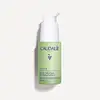What's inside
What's inside
 Key Ingredients
Key Ingredients

 Benefits
Benefits

 Concerns
Concerns

 Ingredients Side-by-side
Ingredients Side-by-side

Water
Skin ConditioningRosa Damascena Flower Water
MaskingAlcohol
AntimicrobialNiacinamide
SmoothingTriethyl Citrate
MaskingCitric Acid
BufferingButylene Glycol
HumectantGluconolactone
Skin ConditioningSodium Citrate
BufferingPalmitoyl Grape Seed Extract
Skin ConditioningXanthan Gum
EmulsifyingSalicylic Acid
MaskingSodium Hydroxide
BufferingSodium Hyaluronate
HumectantHelianthus Annuus Seed Oil
EmollientTocopherol
AntioxidantCitral
PerfumingPelargonium Graveolens Flower Oil
MaskingMentha Piperita Oil
MaskingCymbopogon Citratus Leaf Oil
MaskingRosmarinus Officinalis Leaf Oil
MaskingCitronellol
PerfumingGeraniol
PerfumingSodium Phytate
Linalool
PerfumingLavandula Hybrida Oil
EmollientMelissa Officinalis Leaf Oil
MaskingLimonene
PerfumingWater, Rosa Damascena Flower Water, Alcohol, Niacinamide, Triethyl Citrate, Citric Acid, Butylene Glycol, Gluconolactone, Sodium Citrate, Palmitoyl Grape Seed Extract, Xanthan Gum, Salicylic Acid, Sodium Hydroxide, Sodium Hyaluronate, Helianthus Annuus Seed Oil, Tocopherol, Citral, Pelargonium Graveolens Flower Oil, Mentha Piperita Oil, Cymbopogon Citratus Leaf Oil, Rosmarinus Officinalis Leaf Oil, Citronellol, Geraniol, Sodium Phytate, Linalool, Lavandula Hybrida Oil, Melissa Officinalis Leaf Oil, Limonene
Water
Skin ConditioningButylene Glycol
HumectantGlycerin
HumectantHexyldecanol
EmollientHexyldecyl Laurate
EmollientSqualane
EmollientTocopheryl Acetate
AntioxidantC20-22 Alkyl Phosphate
EmulsifyingPalmitoyl Grapevine Shoot Extract
AntioxidantC20-22 Alcohols
Emulsion StabilisingPotassium Cetyl Phosphate
EmulsifyingPolyacrylate Crosspolymer-6
Emulsion StabilisingHelianthus Annuus Seed Oil
EmollientCaprylyl Glycol
EmollientParfum
MaskingHydrolyzed Hyaluronic Acid
HumectantSodium Dehydroacetate
PreservativeHyaluronic Acid
HumectantAdenosine
Skin ConditioningSodium Hydroxide
BufferingAcetyl Dipeptide-1 Cetyl Ester
Skin ConditioningPentylene Glycol
Skin ConditioningSodium Phytate
Khaya Senegalensis Bark Extract
Skin ProtectingMaltodextrin
AbsorbentLinalool
PerfumingLimonene
PerfumingPaeonia Lactiflora Root Extract
Skin ConditioningCoumarin
PerfumingNicotiana Benthamiana Hexapeptide-40 Sh-Polypeptide-47
Skin ConditioningWater, Butylene Glycol, Glycerin, Hexyldecanol, Hexyldecyl Laurate, Squalane, Tocopheryl Acetate, C20-22 Alkyl Phosphate, Palmitoyl Grapevine Shoot Extract, C20-22 Alcohols, Potassium Cetyl Phosphate, Polyacrylate Crosspolymer-6, Helianthus Annuus Seed Oil, Caprylyl Glycol, Parfum, Hydrolyzed Hyaluronic Acid, Sodium Dehydroacetate, Hyaluronic Acid, Adenosine, Sodium Hydroxide, Acetyl Dipeptide-1 Cetyl Ester, Pentylene Glycol, Sodium Phytate, Khaya Senegalensis Bark Extract, Maltodextrin, Linalool, Limonene, Paeonia Lactiflora Root Extract, Coumarin, Nicotiana Benthamiana Hexapeptide-40 Sh-Polypeptide-47
 Reviews
Reviews

Ingredients Explained
These ingredients are found in both products.
Ingredients higher up in an ingredient list are typically present in a larger amount.
Butylene Glycol (or BG) is used within cosmetic products for a few different reasons:
Overall, Butylene Glycol is a safe and well-rounded ingredient that works well with other ingredients.
Though this ingredient works well with most skin types, some people with sensitive skin may experience a reaction such as allergic rashes, closed comedones, or itchiness.
Learn more about Butylene GlycolHelianthus Annuus Seed Oil is the oil derived from the seeds of a Sunflower. Sunflower seed oil is non-fragrant. It is an emollient, meaning it helps to soften the skin.
Sunflower seed oil contains many fatty acids. The fatty acids found in sunflower seeds include (from highest amount to least): linoleic acid, myristic acid, palmitic acid, stearic acid, arachidic acid, oleic acid, and linolenic acid.
These fatty acids help the skin create ceramides. Ceramides play a role in repairing the skin barrier.
Helianthus Annuus Seed Oil helps moisturize the skin. This in turn helps the skin look more rejuvenated and smoother.
Sunflowers are rich in vitamin E.
Historians believe Indigenous cultures of North America domesticated sunflowers before corn. Thus they relied on sunflower oil for a variety of uses. One such use is moisturizing skin and hair.
Sunflower seed oil may not be fungal acne safe. We recommend speaking with a professional if you have any concerns.
Learn more about Helianthus Annuus Seed OilLimonene is a fragrance that adds scent and taste to a formulation.
It's found in the peel oil of citrus fruits and other plants such as lavender and eucalyptus. The scent of limonene is generally described as "sweet citrus".
Limonene acts as an antioxidant, meaning it helps neutralize free radicals.
When exposed to air, oxidized limonene may sensitize the skin. Because of this, limonene is often avoided by people with sensitive skin.
The term 'fragrance' is not regulated in many countries. In many cases, it is up to the brand to define this term. For instance, many brands choose to label themselves as "fragrance-free" because they are not using synthetic fragrances. However, their products may still contain ingredients such as essential oils that are considered a fragrance.
Learn more about LimoneneLinalool is a fragrance and helps add scent to products. It's derived from common plants such as cinnamon, mint, citrus, and lavender.
Like Limonene, this ingredient oxidizes when exposed to air. Oxidized linalool can cause allergies and skin sensitivity.
This ingredient has a scent that is floral, spicy tropical, and citrus-like.
Learn more about LinaloolSodium Hydroxide is also known as lye or caustic soda. It is used to adjust the pH of products; many ingredients require a specific pH to be effective.
In small amounts, sodium hydroxide is considered safe to use. However, large amounts may cause chemical burns due to its high alkaline.
Your skin has a natural pH and acid mantle. This acid mantle helps prevent harmful bacteria from breaking through. The acid mantle also helps keep your skin hydrated.
"Alkaline" refers to a high pH level. A low pH level would be considered acidic.
Learn more about Sodium HydroxideSodium Phytate is the synthetic salt form of phytic acid. Phytic acid is an antioxidant and can be found in plant seeds.
Sodium Phytate is a chelating agent. Chelating agents help prevent metals from binding to water. This helps stabilize the ingredients and the product.
Water. It's the most common cosmetic ingredient of all. You'll usually see it at the top of ingredient lists, meaning that it makes up the largest part of the product.
So why is it so popular? Water most often acts as a solvent - this means that it helps dissolve other ingredients into the formulation.
You'll also recognize water as that liquid we all need to stay alive. If you see this, drink a glass of water. Stay hydrated!
Learn more about Water